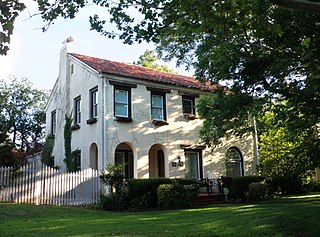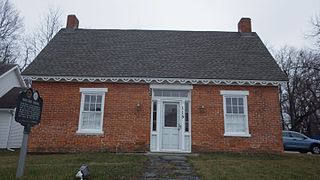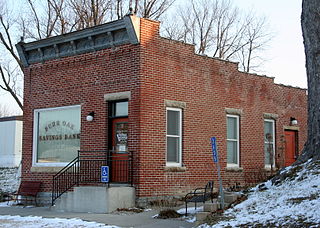
Pinellas County is located on the west central coast of the U.S. state of Florida. As of the 2020 census, the population was 959,107, making it the seventh-most populous county in the state. It is also the most densely populated county in Florida, with 3,491 residents per square mile. The county is part of the Tampa–St. Petersburg–Clearwater Metropolitan Statistical Area. Clearwater is the county seat. St. Petersburg is the largest city in the county, as well as the largest city in Florida that is not a county seat.

Clearwater is a city and the county seat of Pinellas County, Florida, United States, west of Tampa and north of St. Petersburg. To the west of Clearwater lies the Gulf of Mexico and to the southeast lies Tampa Bay. As of the 2020 census, the city had a population of 117,292. It is the smallest of the three principal cities in the Tampa–St. Petersburg–Clearwater metropolitan area, most commonly referred to as the Tampa Bay area.

Lincoln Terrace is a historic and diverse neighborhood in the Eastside district of Northeast Oklahoma City, located on either side of Lincoln Blvd just south of the Oklahoma State Capitol, between NE 13th and NE 23rd streets.] Most homes in the area were built during the decade (1920–30) after the erection of the state capitol. The neighborhood has undergone a renaissance in recent years in part as a result of the expansion of the Oklahoma Health Center district, anchored by the University of Oklahoma Health Sciences Center, on its south side.

The Donald Roebling Estate, also known as Spottiswoode and Spotswood, is a historic residential estate in Clearwater, within Pinellas County on the West coast of Florida.

The Frank Lloyd Wright/Prairie School of Architecture Historic District is a residential neighborhood in the Cook County, Illinois village of Oak Park, United States. The Frank Lloyd Wright Historic District is both a federally designated historic district listed on the U.S. National Register of Historic Places and a local historic district within the village of Oak Park. The districts have differing boundaries and contributing properties, over 20 of which were designed by Frank Lloyd Wright, widely regarded as the greatest American architect.

The Peter A. Beachy House is a home in the Chicago suburb of Oak Park, Illinois that was entirely remodeled by architect Frank Lloyd Wright in 1906. The house that stands today is almost entirely different from the site's original home, a Gothic cottage. The home is listed as a contributing property to the Frank Lloyd Wright-Prairie School of Architecture Historic District, which was listed on the U.S. National Register of Historic Places.

Edwin H. Cheney House (1903) located in Oak Park, Illinois, United States, was Frank Lloyd Wright's design of this residence for electrical engineer Edwin Cheney. The house is part of the Frank Lloyd Wright–Prairie School of Architecture Historic District. A brick house with the living and sleeping rooms all on one floor under a single hipped roof, the Cheney House has a less monumental and more intimate quality than the design for the Arthur Heurtley House. The intimacy of the Cheney house is due to the building not being a full story off the ground and being sequestered from the main street by a walled terrace. In addition, its windows are nestled between the wide eaves of the roof and the substantial stone sill that girdles the house.

This is a list of the National Register of Historic Places listings in Pinellas County, Florida.

The Hamilton-Brown Shoe Factory was the first large scale industrial operation in Columbia, Missouri. It was built in 1906-1907 by the Brown Shoe Company, the largest shoe manufacture in the world at the time. It was the first plant built outside of St. Louis and was operational from 1907-1939 The building today has been converted into offices.
The North Ninth Street Historic District is a national historic district located at Downtown Columbia, Missouri, USA. It encompasses seven contributing buildings in an area that has historically been a center of commerce, recreation and culture. They were built between about 1885 and 1954, and are the L.J. Slate Billiard Hall, Allen Arnold Building, A. Victor Building, Lafayette Hume Building, Varsity Theatre (1927), Crosswhite Bakery, and Hume Building. The popular music venue The Blue Note is located within the district.

South Buffalo North Side Light is a lighthouse formerly located at the entrance to Buffalo Harbor, Buffalo, New York. It is one of two "bottle shaped" beacons located in Buffalo Harbor; the other is the Buffalo North Breakwater South End Light. It is a 29-foot (8.8 m) high beacon constructed of boiler plate. It measures 10 feet 3⁄4 inch (3.067 m) at the bottom and 2 feet 3 inches (0.69 m) at the top. It is distinguished by four cast iron port windows and a curved iron door. It was first lit on September 1, 1903, and originally equipped with a 6th-order Fresnel lens. A battery operated 12 volt lamp with a 12-inch (300 mm) green plastic lens was installed in the beacon c. 1960, when a domed roof formerly mounted over the lens was removed. The beacon was removed in 1985, and now stands at the gate to the Dunkirk Lighthouse and Veterans Park Museum. Its twin is located on the grounds of the Buffalo (main) Light.

The Stephens College South Campus Historic District is a national historic district on the campus of Stephens College in Columbia, Missouri. It includes the historic core of Stephens College in Eastern Downtown Columbia, Missouri. The District includes Senior Hall, Hickman Hall, Columbia Hall, and Wood Hall.

The Kritser House in Independence, Missouri is a building from 1850. It was listed on the National Register of Historic Places in 1985. It is found as significant for being associated with the life of Martin U. Kritser, a person significant to the history and development of the town. It is one of the few middle class residential structures of the American Mid-Victorian frontier architecture period left in Independence.

The East Hill Residential Historic District is a large old neighborhood on the east side of Wausau, Wisconsin where many prominent citizens lived, with about 165 contributing properties built from 1883 to 1945. It was added to the National Register of Historic Places in 2004.

The E.K. Schuetz House is a historic house located in Wausau, Wisconsin. It was added to the National Register of Historic Places in 1980.

The Osceola Park Historic Residential District is in Vero Beach, Florida. It contains the homes of several former city officials from as far back as the 1920s. On January 13, 2013, it was added to the National Register of Historic Places.

Burr Oak Savings Bank – also known as the Burr Oak Post Office – is an historic building located in Burr Oak, Iowa, United States. The free-standing, single-story, brick structure was built in 1910 in the Italianate style. Its primary decorative feature is a panel with corbeled brickwork in a dentil-like pattern, and the bracketed tin cornice above it. In 1931 it suffered a robbery, being the first robbery in Winneshiek County. That same year – as well as in 1941, 1955 and 1967 – the building underwent expansions. After the bank closed, the building was used as a barber shop and the post office, which closed in 1981. In 2014 it became the Visitors Center for the Laura Ingalls Wilder Museum and Park. It is the only building that remains on Burr Oak's main street from a period of economic expansion in early 20th-century Iowa, based on agricultural production and land values. It was listed on the National Register of Historic Places in 2001.

The Living Arts & Science Center, formerly the George B. (Blackburn) Kinkead House, is an art and education center housed in an historic mansion in Lexington, Kentucky. The building is listed on the National Register of Historic Places. It was donated to the center by the Kinkead family in 1981.

Fort Harrison was a United States military post that existed along the west coast of Florida during the Second Seminole War, on a site which now lies within the city of Clearwater. It was named after William Henry Harrison, the then newly inaugurated President of the United States.
Dean Alvord was an American real estate developer, college professor, and philanthropist known for his real estate developments in the New York City Metropolitan Area and in Florida. He was a relative of both Jonathan Edwards and Aaron Burr.























